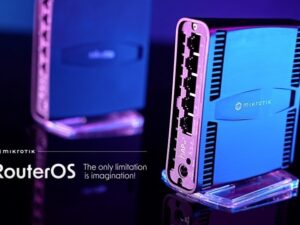ISP Essentials: Understanding the Building Blocks of Connectivity
- Description
- Curriculum
- Reviews
- Grade
In today’s interconnected world, access to the Internet is essential for communication, education, business, and entertainment. As the demand for reliable Internet services continues to grow, so does the opportunity for entrepreneurs to enter the Internet Service Provider (ISP) market.
Welcome to “How to Start an ISP,” a comprehensive course designed to guide you through the process of establishing and running your own Internet Service Provider. Whether you’re a tech-savvy individual with a passion for networking or an entrepreneur looking to tap into a lucrative industry, this course will provide you with the knowledge and tools needed to succeed.
Throughout this course, you will learn about the technical, financial, and regulatory aspects of starting an ISP. We will cover everything from selecting the right technology and equipment, understanding the infrastructure requirements, navigating legal and regulatory hurdles, to marketing your services, and managing customer relations.
By the end of this course, you will have a clear understanding of the steps involved in launching an ISP, equipped with practical insights and strategies to build and grow your business. Join us on this exciting journey to become a key player in the world of internet connectivity!
-
1Introduction to ISPsText lesson
Overview:
This lesson provides a comprehensive introduction to Internet Service Providers (ISPs). Participants will gain a clear understanding of what ISPs are and their essential role in the digital ecosystem. The lesson will cover the importance of ISPs in enabling internet access and supporting the digital economy. Additionally, it will differentiate between the various types of ISPs (local, regional, national) by highlighting their unique characteristics, scope of operation, and market focus.
-
2Identify Different Types of ISPsText lesson
Identify Different Types of ISPs
Overview:
This lesson will focus on identifying and differentiating between various types of Internet Service Providers (ISPs), including local, regional, national, Tier 1, Tier 2, and Tier 3 ISPs. Participants will understand the unique characteristics and operational scopes of each type of ISP, providing a clear picture of how different ISPs serve their markets and connect within the broader internet infrastructure.
-
3Types of ISP Business ModelsText lesson
By the end of this lesson, participants will have a thorough understanding of various ISP business models, revenue streams, and cost structures. They will be equipped with the knowledge to choose a suitable business model for their ISP and develop strategies for financial success and growth.
-
4Legal and Regulatory LandscapeText lesson
Legal and Regulatory Landscape
Overview
Understanding the legal and regulatory landscape is crucial for the successful operation of an Internet Service Provider (ISP). This lesson covers the various regulations affecting ISPs at both local and national levels, licensing requirements, and compliance with data protection and privacy laws. By gaining insights into these aspects, participants will be better equipped to navigate the legal complexities of running an ISP and ensure their operations are compliant with all relevant laws.
-
5Market Entry StrategiesText lesson
Successfully entering the ISP market requires careful planning and strategic decision-making. This lesson explores different market entry strategies, the importance of partnerships and alliances, and the geographic considerations crucial for service area planning. Participants will learn how to choose the right approach for their ISP, leveraging partnerships for growth, and effectively planning their service areas to maximize coverage and customer acquisition.
-
6Foundations of ISP Network ArchitectureText lesson
Overview
Understanding the fundamental architecture of an ISP network is crucial for anyone looking to start or operate an Internet Service Provider. This lesson provides a comprehensive introduction to the core concepts, components, and design principles essential for building a robust ISP network. Participants will gain insights into the different layers of network architecture and the importance of strategic network design.
-
7Core and Distribution Network DesignText lesson
The core and distribution networks are the backbone of any ISP infrastructure, playing a critical role in ensuring efficient data transport and routing. This lesson delves into the functions, technologies, and design strategies essential for building and managing robust core and distribution networks. Participants will learn about key technologies, scalability considerations, and the importance of redundancy and high availability.
-
8Introduction to Access NetworksText lesson
The access network is a crucial component of an ISP's infrastructure, serving as the link between end-users and the ISP network. This lesson focuses on the design, implementation, and management of access networks, highlighting various technologies, design considerations, and the critical role of customer premises equipment (CPE).
-
9Border Network DesignText lesson
The border network plays a vital role in an ISP's infrastructure by serving as the interface between the ISP's internal network and external networks, including the broader internet and other service providers. This lesson covers the essential functions, technologies, and strategies involved in designing and managing an effective border network, with a focus on security, policy enforcement, and interconnection agreements.
-
10Internet Exchange Points (IXPs) and InterconnectionsText lesson
Overview
Internet Exchange Points (IXPs) are critical infrastructures that facilitate the exchange of Internet traffic between ISPs and other network providers. This lesson provides an in-depth understanding of IXPs, their role in ISP interconnections, and the strategic benefits they offer. Additionally, the lesson will explore the distinctions between peering and IP transit, highlighting the strategic considerations for establishing effective interconnection agreements.
-
11Network Security, Management, and MonitoringText lesson
Network security, management, and monitoring are essential components of maintaining a robust and reliable ISP infrastructure. This lesson focuses on the critical aspects of securing the ISP network from threats and vulnerabilities, implementing best practices for network management, and employing effective tools and techniques for monitoring network performance.
-
12Introduction to Last-Mile Technologies and ConnectivityText lesson
The "last-mile" refers to the final leg of delivering connectivity from an ISP's network to the end-user's premises. It is a crucial component of an ISP's infrastructure as it directly impacts the quality of service experienced by the customers. This module explores various last-mile technologies, including Fiber to the Home (FTTH), Digital Subscriber Line (DSL), and wireless solutions, alongside hybrid approaches. Additionally, it covers the role and management of Customer Premises Equipment (CPE) and the design considerations essential for implementing effective last-mile networks.
-
13Digital Subscriber Line (DSL)Text lesson
Introduction: DSL is a technology that uses existing telephone lines to provide internet access. It is a cost-effective solution widely used in areas where fiber deployment may not be feasible.
-
14Fiber to the X (FTTX)Text lesson
FTTX encompasses a range of fiber-optic broadband network architectures that extend fiber connectivity from the ISP’s network to various points in the end-user’s network, including Fiber to the Home (FTTH), Fiber to the Building (FTTB), Fiber to the Curb (FTTC), and more.
-
15Wireless TechnologiesText lesson
Introduction: Wireless technologies, including Wi-Fi, LTE, and 5G, provide flexible and quick deployment options for last-mile connectivity, especially in remote or hard-to-reach areas.
-
16Hybrid SolutionsText lesson
Hybrid solutions involve combining multiple last-mile technologies to optimize coverage, performance, and cost-effectiveness.
-
17Customer Premises Equipment (CPE)Text lesson
CPE refers to the equipment located at the customer's premises, such as modems, routers, and set-top boxes. Proper management and configuration of CPE are crucial for ensuring optimal service delivery.
-
18Design Considerations for Last-Mile NetworksText lesson
Designing last-mile networks requires careful planning and consideration of various factors to ensure comprehensive coverage, capacity management, and high-quality service delivery.
-
19Regulatory and Compliance ConsiderationsText lesson
Understanding the regulatory landscape and compliance requirements is essential for ISPs to operate legally and effectively. This lesson focuses on the legal aspects and standards that ISPs must adhere to in their last-mile deployments.
-
20Cost Management and OptimizationText lesson
Effective cost management is crucial for sustainable ISP operations. This lesson covers strategies for managing and optimizing costs associated with last-mile technologies and infrastructure.
-
21Day-to-Day ISP OperationsText lesson
Understand ISP Operations: Gain comprehensive knowledge of day-to-day ISP operations and best practices for managing them.
Implement Effective Management Strategies: Learn how to manage resources, staff, and infrastructure to ensure efficient and reliable service delivery.
Develop Expansion Plans: Understand the factors involved in scaling ISP operations and entering new markets, including planning, implementation, and evaluation.
-
22Resource and Infrastructure ManagementText lesson
Learn how to efficiently manage the resources and infrastructure of an ISP.
Understand the importance of capacity planning and resource allocation.
-
23Staff Management and TrainingText lesson
- Develop strategies for recruiting, training, and managing ISP staff.
- Understand the importance of continuous professional development.
-
24Network Security and Data ProtectionText lesson
Understand and implement security practices to protect the ISP network and customer data.
Learn how to respond to security incidents and mitigate risks.
-
25Customer Experience and EngagementText lesson
Learn techniques for improving customer satisfaction and engagement.
Understand the importance of customer feedback and service quality.
-
26Emerging Technologies and InnovationsText lesson
- Identify new technologies and innovations that impact ISPs.
- Understand how these technologies can be applied to enhance ISP services.
-
27Case Studies of Successful ISPsText lesson
Analyze successful ISP implementations to understand best practices.
Learn from the experiences and strategies of established ISPs.

Popular Courses
Archive
Working hours
| Monday | 9:30 am - 6.00 pm |
| Tuesday | 9:30 am - 6.00 pm |
| Wednesday | 9:30 am - 6.00 pm |
| Thursday | 9:30 am - 6.00 pm |
| Friday | 9:30 am - 5.00 pm |
| Saturday | Closed |
| Sunday | Closed |







